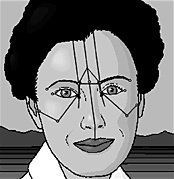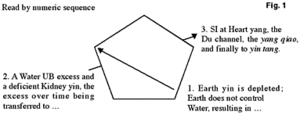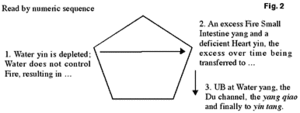People today want convenience, whether it be from their bank, credit card, favorite retail store, or restaurant. They demand it from the companies who hold their loyalty, including their health care providers (you). They don’t want to call and possibly be put on hold, and they want to use an app or schedule an appointment on your website. Here are three reasons your practice can gain by switching to online appointment scheduling.
The Great Mystery of Yin Tang
What is the great mystery of the point, yin tang? Why does the area register Heart yang excess exclusively? What are the nine diagnostic colors most likely to be seen on it? And what is the likely diagnosis and treatment protocol to contain this?
Half of the mystery to the point is that it so faithfully records any excess of yang in general, and Heart yang in particular. The other half of the mystery is that this aspect is often missed while taking a patient's history, and is not taken into account even when it sits in full view at all times.

This article hopes to resolve the first half of the mystery of yin tang by explaining the nature of the point and its critical location as a junction of the many channels that run Fire qi in one manner or the other. The other half is something each practitioner can resolve on a personal level.
Channels That Course Through or Alongside Yin Tang
- The Du channel, which runs through it squarely and superoinferiorly.
- The UB 2 points, at the medial ends of the eyebrows.
- The UB 1 points, at the inner canthus of the eyes.
- The yang qiao extraordinary channel, which traverses the inner canthus on its way over the scalp to GB 20.
- The SI channel, indirectly, when a terminal branch at the cheek drains into UB 1 (notes, reference #2).
How Are These Vessels Connected to the Heart Yang?
- The Du channel connects to yang qiao to form one of the eight extraordinary channel pairs.
- The yang qiao connects to UB where it originates at the lateral side of the heel at UB 61 and 62. In addition, points UB 62 and SI 3 used to stimulate this pair belong to the yang particles of the Water and Fire elements. This reinforces the connection (notes, reference #1).
- The essential Fire yang quality is brought in by the terminal portion of the SI vessel at the cheek, which sends a connecting branch to the inner canthus, draining its Fire qi into UB.
- Further, Du 14 provides a meeting place for all yang channels, including the SI.
- An additional quality of Fire heat yang qi is seen when UB connects to SI via the shao-yang bond (notes, reference #3).
How Do These Connections Influence Color Changes on the Yin Tang?
All of these channels carry some aspect of the Fire element, which is by nature yang, heated and red. When these run in close proximity to the yin tang, its anatomically encroached nature turns it into a natural "draining basin" of this specialized and quite obvious qi. Situated on the most visible part of the face, on a bony substratum quite near the surface, it becomes a sensitive reflector of the most visible kind of body qi (see above image).
Nine Color Changes on the Yin Tang Area and Their Clinical Implications
- If the color is pinkish, a Fire yang rising disturbance is in the making.
- If the color is a darker hue/reddish, a Fire yang rising condition is turning grave.
- If the color is a frank red, but uniform, the Fire yang is established.
- If the color is a frank red, but not uniform, and mixed with purplish patches, stagnation of Heart qi is also in the mix.
- If a red matrix has darker red points on it, the Heart Fire is about to become rampant.
- If a dull red matrix has blotches of brown, the Heart heat has settled down and become chronic, but is by no means contained.
- If a dull red matrix has blotches of white, the illness, which was free-standing Fire, has changed character and become Fire invading Metal, with far more serious implications.
- If any of the color changes mentioned above are central, the illness is uniformly symmetric.
- If any of the color changes mentioned above are more to one side than another, the illness is asymmetric. An element of asymmetry is an important etiologic factor (more reading, reference #2).
Additional Textural Skin Changes at Yin Tang
- If the skin of the area feels rough, the Fire is attacking Metal, or the fluid is tending to dryness.
- If the skin of the area has taken on a well-marked, flaky, dry look, one or the other of the two conditions listed above is becoming pronounced.
- If the skin of the area is decidedly dry and fissured, the invasion of Metal by Fire is established, or the fluid is in an extreme state of dryness.
- If the signs of dryness and flaky deposits extend to the medial ends of the eyebrows, the invasion of Fire into Metal by the ko cycle has in turn extended into Water yang, by way of the shen extension.
Possible Diagnoses
Two diagnoses are possible, with distinct etiology but a strikingly similar clinical profile. While other conditions are possible, these two were chosen because in the author's experience of the author, they are the ones most commonly seen.
- A common Spleen deficiency with Water UB yang full, which has mutated, by the UB-SI connection, to an SI excess, mimicking the symptoms recognized classically as Heat in the heart shifting to the Small Intestine (bibliography, reference #1).
- A complex Kidney yin illness, which has progressed via the ko connection to a serious hyperactivity of the Fire of the Heart (bibliography, reference #1).
The first condition begins as an Earth yin depleted condition, which does not control Water, resulting in UB yang excess, which in time transfers its heated qi to SI, which shows up as heat and Fire-oriented color changes on the yin tang.
The second condition is a Water yin depleted condition, which does not control Fire, resulting in excess SI yang, which transfers to UB and shows up as heat and Fire-oriented color changes on the yin tang.
Does One Look for Supporting Diagnostic Features?

Yes and no. Chi Po, the sage in the Nan-Ching Classic, extols the ability of a healer to diagnose exclusively from color changes in the complexion of the face. If one can do this, he or she is the highest of practitioners, a spirit healer (more reading, reference #1).
Until one reaches that stage, it is expedient to support any diagnosis, even the most obvious one, with enough parameters so one is certain what one is treating. In case you are wondering, the other categories of healers Chi Po designates are, the Sage at the second station, who heals exclusively by listening to the elemental sound; the Artisan at the third stage, who heals exclusively by the elemental taste; and the Workman or Workwoman at the fourth stage, who works exclusively by palpating the vessels.
Interestingly, in the first condition, the yin tang is inundated by UB Water yang excess, and in the second condition, by an SI Fire yang excess, a near perfect illustration in clinical terms of the elemental mutative designs on Fire-Water axis, so that one may jump from the frying pan into the Fire, but surface straight up out of the ocean.
What Treatment Strategy Does This Dictate?

The first condition arises when the Spleen registers a deficiency, which in turn causes an excess in UB. To reverse this, the Spleen is toned with a mother Fire point, and the excess in UB is reduced with a son Wood point.
The second condition arises when Water yin registers a deficiency, which in turn causes an excess in SI. To reverse this, the Kidney is toned with a mother Metal point, and the excess in SI reduced with a son Earth point.
If you happen to choose the points from the 5 Shu grid to access exact element-specific qi (and in addition, these are time-specific by the 24 hour horary clock), the results can be dramatic (notes, reference #4).
The Yin Tang as a Monitor of the Success of Treatment
The area is very sensitive and will readily reflect a lessening of excess heat and yang. In that sense, the success of any treatment protocol one chooses to apply.
If the yin tang, which was discolored, becomes homogenous and of normal hue, the inescapable conclusion is that the Heart yang excess has settled down.
Concluding Thoughts
The yin tang is one of the few very visible points on the body with remarkable and entirely predictable changes. It is a unique window on the state of the Heart qi, and readily delivers easily read markers to the astute diagnostician. More than that, it is a readily available monitor of the success of a treatment protocol, and finally a marvelous indicator of a balanced Heart yang qi.
This brings us to the mystery aspect all over again, which is: Why isn't the yin tang the first parameter looked at when one suspects a Fire yang condition?
Bibliography
- Essentials of Chinese Acupuncture. Foreign Languages Press, Beijing, China, 1993. The syndromes of the small intestine, part II, differentiation of syndromes, chapter seven, p. 73. The syndromes of the heart, hyperactivity of the fire of the heart, part II, differentiation of syndromes, chapter seven, p. 67.
Author's note: Clinical data and methodology are presented here are original findings gleaned from years of practice and clinical application; there are no more references, as there are none to give.
Notes
- The yin qiao vessel runs as a pair with the ren, draining into the yang qiao at the inner canthus. It does not extend to the vicinity of the yin tang and therefore does not participate in the yin tang dynamics.
- Actually, the SI channel does not connect directly to UB, as one would expect, from the last point (SI 19), but circuitously via a branch from the supraclavicular fossa to SI 18 under the zygomatic arch, and into UB 1 at the inner canthus.
- The SI channel forms an above-and-below bond with the UB, known as the tai-yang bond.
- Kaikobad H. Point Locator Chart for Time-Specific High Energy 5-Shu Toning & Reducing Points. TruSelf, Inc., 7724 E Meadowbrook Ave, Scottsdale, AZ 75251; © 2002. Copies available at (888) 878-7353.
More Reading
- The Classic of Difficult Issues, part II, chapter four: on illness, the 61st difficult issue. In: Unsschuld PU (ed). Nan Ching. Regents of the University of California; University of California Press, 1986, p. 539. This issue discusses the importance of reading exclusively; color changes in facial complexion; and arriving at a complete diagnosis. Such a person in the estimation of Chi Po, the sage of Nan Ching, is given the highest station, that of the spirit healer.
- Hara diagnosis - overview. In: Matsumoto K, Euler D (eds). Kiiko Matsumoto's Clinical Strategies. Published by Kiiko Matsumoto International, 2002, pp 14-25. This work introduces a masterful understanding of body symmetry, and how asymmetry can cause a myriad of illnesses. Interestingly, if an existing asymmetry is not corrected, the best of treatment may fail. Alternately, if the asymmetry is corrected, further treatment may become unnecessary.
- Kaikobad H. Point Locator Chart for Time-Specific High Energy 5-Shu Toning & Reducing Points. Scottsdale, AZ: TruSelf Inc., 2002. This chart explains in detail the horary times of element-specific mother toning or son reducing points open round the clock. This makes available a powerful tool for the astute healer.



